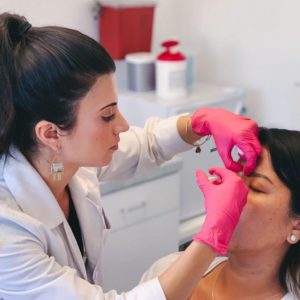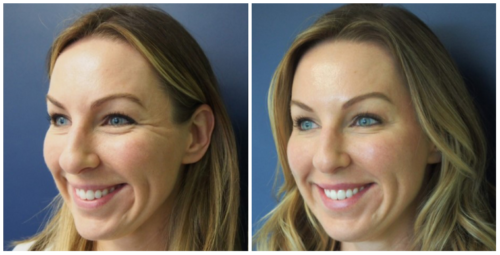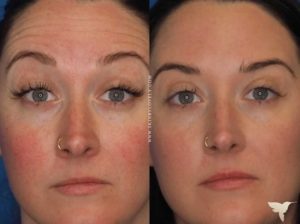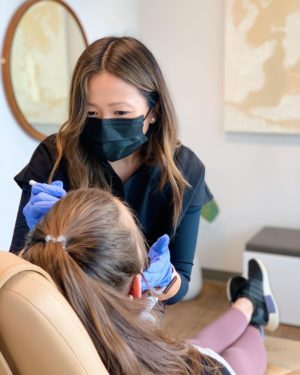Camas, WA
Injectables
Skin Rejuvenation
Hair Restoration & Growth
Shop By Brand
Botox is a well-known treatment used to reduce facial wrinkles and relieve various medical conditions. It’s been used successfully for many years in the U.S. for cosmetic purposes, and providers perform millions of procedures with it each year. Botox has some competition, however. In 2009, Dysport entered the U.S. market reporting the same benefits as Botox — the Food and Drug Administration (FDA) approved it in 2009 — but it has been used in Europe for well over a decade as a popular Botox alternative.
Allergan makes Botox and had an exclusive U.S. cosmetic market from 2002-2009. Medicis Aesthetics, which were the original makers of Restylane and Restylane Lyft, was behind Dysport, and they presented the first real competition to Botox. Dysport is now owned by Galderma and has gained traction as a popular botulinum toxin for wrinkle reduction to the point where many patients now request it by name.

No doubt, people asked comparable questions when Botox was new as well. Many of the answers are comparable, too, and can be found below. If you have any other questions beyond what we’ve covered here, contact our practices in Santa Monica, CA and Portland, OR to speak with our certified injection specialists for details about Botox and Dysport and schedule a consultation. We’ll help you determine which injectable is right for you.
The short answer is yes, in many cases, choosing Dysport or Botox is a matter of preference for either the person receiving the treatment or the licensed injection specialist performing the procedure. There are a few differences separating the two products, but they are actually quite similar.
Both Dysport and Botox are forms of botulinum toxin type A, which is extracted for safe use in humans to relax muscles and decrease movement. Biologically and chemically, they are almost identical, both containing the same 150 kilodalton active core. Dysport does have greater variability in the size and molecular weight of the accesory (protective) protiens attached to this core, which Botox has a consistent size and weight of 900 kilodaltons. Clinically, this does lead to some differences discussed below. What is most important is that they use the exact same mechanism of action in the muscle. Both product relax muscle tissue and prevents it from responding to the nerve impulses that control muscle contraction. Repeated muscle contractions are the cause of those wrinkles that so many people want to eliminate. Over time, smiling and squinting result in crows’ feet around your eyes, frowning creates lines between your brows and raising your eyebrows etches forehead lines. Dysport and Botox seek to reduce the appearance of these lines; with regular upkeep and visits to certified injection specialists with a focus on a natural-looking anti-aging aesthetic, you will find you look rejuvenated and more youthful, not frozen or scary like the media likes to report.
Introducing the botulinum toxin in small, injected amounts temporarily blocks contractions in the treated muscle area and relaxes it, reducing the appearance of wrinkles. Both Dysport and Botox help improve the appearance of facial lines in this way. When the treatment fades, the lines reappear. Repeated injections are necessary, and your injection specialist will tell you when you should come in again for touch-up treatments.
Some of the differences between the products come from their formulas. Dysport is more diluted than Botox, which changes the dosage level. If you’re used to a certain number of units with your Botox treatments, that number will likely increase when switching to Dysport. Greater dilution doesn’t make it less effective; the dosage is mainly a consideration for the injection specialist who administers the treatment. Dysport has smaller protein molecules as well, which may reduce the formation of antibodies that eventually break down the formula and reduce its effectiveness.
Because of these formula and structural differences, Dysport behaves a bit differently in the body than Botox does. Dysport tends to diffuse more, causing it to spread out over a broader area after it’s injected. This can be beneficial when treating a larger area, such as wide forehead wrinkles, and areas with thinner muscles, such as crows’ feet.
Greater diffusion means fewer injections to achieve desired results, and fewer injections mean less discomfort. It also means that Dysport may not work as well for treating small areas or areas with thicker muscles, such as the space between your eyebrows or around your mouth. While an experienced injection specialist who knows facial musculature quite well can control the diffusion and keep the treatment area very specific, Botox may simply be better for some areas and Dysport for others.
Additionally, some people who have not responded to Botox report that Dysport works well for them; these are personal reports that don’t yet have clinical proof to support them.

Most studies comparing the two products have focused on their uses for medical conditions rather than as cosmetic treatments. However, an early 2004 review showed that patients were more satisfied with Botox than Dysport for treating the wrinkles between their eyebrows. This was before Dysport’s 2009 FDA approval.
Another study, reported in 2011, set out to determine the specific differences between Dysport and Botox. The researchers accomplished this by injecting one side of patients’ faces with Dysport and the other side with Botox. The 30-day study found a noticeable difference in the treatment of crows’ feet specifically.
When the research subjects smiled, the sides treated with Dysport showed fewer wrinkles than the sides treated with Botox. With neutral facial expressions, there was no significant difference. Medicis Aesthetics funded that particular study. Researchers asked Allergan for funding support as well. They did not provide any, and they later disputed the findings.
Even in examining treatment for medical conditions, the products’ different formulas present some difficulties. There isn’t one clinically accepted conversion ratio used to compare the thinner, more diluted Dysport to the thicker, more concentrated Botox. Many cosmetic providers use a 3:1 ratio, meaning that three units of Dysport equal one unit of Botox, but that hasn’t yet been confirmed. The providers at each Skin by Lovely location use what might be called a variable dose ratio, depending on which area of the face is being injected, and the strength of those muscles.
This uncertainty may have led to Allergan’s complaints about the “crows’ feet study” because researchers used more Dysport than Botox. Allergan stated that using more Botox would provide better results as well. Without a confirmed ratio, the complaint may be valid; yet calling for equal doses doesn’t account for Botox’s concentrated formula.
The competition developing between the two companies can be good for consumers, but differing medical claims can make it hard to know what’s best. The current pricing for the products is virtually identical, once you adjust for the conversion ration. As it stands, both Dysport and Botox are effective and considered safe for treatment of facial wrinkles. Botox may be better for small treatment areas, and Dysport might be the better choice for crows’ feet and larger treatment areas. Your injection specialist can help you decide the best options for your particular needs after a thorough consultation.
One matter not in dispute is the importance of always receiving treatment from an experienced, medically licensed injection specialist. Knock-off and counterfeit products are unsafe, and anyone who isn’t a licensed medical professional and experienced in the procedure could cause more harm than good. When making the Dysport vs Botox decision, the qualifications of the person injecting the product are more important than which product you choose. Choose only medical professionals who are doctors, physician assistants and nurses who have had extensive training and certification in the use of injectables and aesthetics. An aesthetician, for example, should not be performing injectable treatments and can account for many concerns surrounding Botox and other injectables across the country. While there are some states that do allow for non-medical professionals to inject Botox, this has been the focus of investigative reports and some tough questions directed at lawmakers.
The dosage used for cosmetic treatments is relatively small, and Dysport side effects are generally mild. Here again, it’s fairly similar to Botox.
There may be some stinging or burning sensations during the injection as well as swelling or bruising afterward. You may also feel some pain where Dysport was injected or have a skin reaction to the formula, including redness, itching or rash. You might experience a heavy feeling at the injection site; this usually disappears within a couple of weeks.
Some people report headaches or cold and flu-like symptoms, such as a runny nose, sore throat or respiratory symptoms. You may also experience dry mouth and tiredness. These are all temporary and usually minimal. The injection area might feel numb as well, and due to the nature of the treatment, there will be little or no facial movement in the treated area.

While Dysport, like Botox, is considered safe in its small doses, the main ingredient is the toxin that causes botulism. There is a possibility of it spreading to other areas and causing more severe problems within hours or weeks after an injection. These Dysport side effects can include drooping eyebrows or eyelids, blurred vision, difficulty speaking, hoarseness, muscle weakness, loss of bladder control, and trouble breathing or swallowing. These are seen more often with the larger doses used for medical conditions, but the possibility does exist with cosmetic doses, though that possibility is exceptionally small. Seek medical care right away if these occur. A thorough medical history provided to your licensed medical injection specialist will help prevent any serious side effects from occurring.
Severe reactions are rare, but if you’re allergic to any of the ingredients in Dysport, you might experience trouble breathing, speaking or swallowing. Again, seek immediate care if these occur. Less severe allergic symptoms could include itching, rash, wheezing, dizziness, fainting or asthma symptoms. You should also seek medical care with these symptoms. Be sure to report any and all allergies you have to your injection specialist during your consultation, including allergies to medications, anesthetics and food.
The lactose in Dysport comes from cow’s milk. It rarely causes intolerance problems because it doesn’t enter the digestive system; however, it could cause allergic reactions for patients who are allergic to dairy products. The formula contains human albumin as well, which is a protein found in normal blood plasma. This, too, rarely causes problems but is worth listing. The botulinum toxin already discussed is the third main ingredient and is safely used for cosmetic purposes. There have been no reported cases of botulism from cosmetic Botox and Dysport injections as of the date of this article’s publication.
Women who are pregnant, who are planning to be pregnant or who are chestfeeding shouldn’t receive Dysport. People with neuromuscular conditions should also avoid treatment. Other conditions can be problematic too, and there can be negative medication interactions as well. Be sure to disclose all your health conditions and medicines to your medically licensed injection specialist before receiving treatment.
 Much of the information available on the Internet refers to outdated Dysport rebate offers or may be unusable prescription discounts. Since Dysport is an injection, you don’t fill a prescription in the usual way. Don’t purchase Dysport (or any aesthetic injectable treatment) online. It is illegal to sell this injectable to unlicensed individuals, and you cannot guarantee the legitimacy of the injectable when it’s purchased this way.
Much of the information available on the Internet refers to outdated Dysport rebate offers or may be unusable prescription discounts. Since Dysport is an injection, you don’t fill a prescription in the usual way. Don’t purchase Dysport (or any aesthetic injectable treatment) online. It is illegal to sell this injectable to unlicensed individuals, and you cannot guarantee the legitimacy of the injectable when it’s purchased this way.
There is a program for assistance with treatments for medical conditions, but it requires private insurance coverage; it doesn’t apply to personal, cosmetic treatment. If you require Dysport treatments for medical conditions, speak with your insurance company to determine if your treatment will be covered.
The best resource for current Dysport rebate offers is your professional injection specialist, who is in contact with Dysport representatives on a regular basis and will have the latest rebate information for you. Finally, Galderma announced its Aspire Rewards Program that can provide rewards for Dysport and other Galderma products. Find out more during your next appointment with us.
Providers set their own rates, but Dysport tends to be pretty close to Botox in price. The product itself costs less per unit, but treatment may require a higher number of units than Botox does, which typically evens out the cost. Additionally, some providers charge per unit and some charge by the facial areas treated, making it difficult to generalize. Some providers also set the same prices for both products, turning it into a matter of preference alone. At Skin by Lovely in Santa Monica, CA and Portland, OR, we charge per unit, as this is how Allergan and Galderma charge our practice when we purchase the medications.
The Dysport price averages approximately $4 to $8 per unit, depending on where you live. Botox prices average $12 to $17 per unit, again depending on location. Rebates and other special offers can make a bigger difference than the direct cost, but Dysport, on its own, tends to be a little less expensive than Botox. Be wary of prices that are too good to be true. It could mean that the clinic is using counterfeit injectables, the staff isn’t licensed to provide such treatments, or the injector is inexperienced.
The Dysport cost will vary between different parts of the country and different providers. It also depends on the facial area treated and how many areas you treat at once. Your injection specialist will determine how many units you will need during your consultation and will tell you how much it would cost before your treatments begin.
Viewing a number of sources gives you the most complete picture. These can include the product website, your provider’s site — which offers opinions from their own patients — and reputable medical sources. Understand that some Dysport reviews will focus on negative outcomes, but the product’s longevity in Europe and its growing market in the U.S. show that it is overwhelmingly considered safe. Note also that some negative reviews have nothing to do with the injectable itself, but the way in which is was administered.
After safety and price concerns, perhaps the most frequent question consumers want answered is, “How long does Dysport last?” Some people think that Dysport starts working sooner than Botox does, or lasts longer, but these are anecdotal reports.
Botox usually takes a few days to a week to show real results while Dysport may present visible changes a bit sooner in some people. Botox then typically lasts three or six months, with Dysport showing similar longevity. These results also vary from patient to patient. So, much like Coke and Pepsi, it comes down to personal preference.
While you’re considering treatment, you’ll want to review Dysport before and after pictures. Your injection specialist’s website or Instagram will have some great photos of patients they have treated, and the Dysport official site also has some pictures that show notable results. The effects can be quite dramatic. Reviewing these before and after photos may help you decide to try Dysport for yourself.
We’re ready to help you look and feel your best. Schedule a consultation with one of our aesthetic injection specialists today and get started.
About Skin by Lovely™
Skin by Lovely specializes in FDA-approved, natural-looking, non-surgical, medical facial aesthetics and rejuvenation treatments. With practices in Santa Monica, CA, Portland, OR, and Lake Oswego, OR. Skin by Lovely is certified by Allergan, the makers of Botox® and Juvederm®, as a Top 10 facial aesthetic practice in the United States and a Top 25 account for Galderma, the makers of Dysport® and Restylane®. Get the treatment you deserve at Skin by Lovely.
More information can be found at skinbylovely.com or you can view more before and afters on our Instagram.